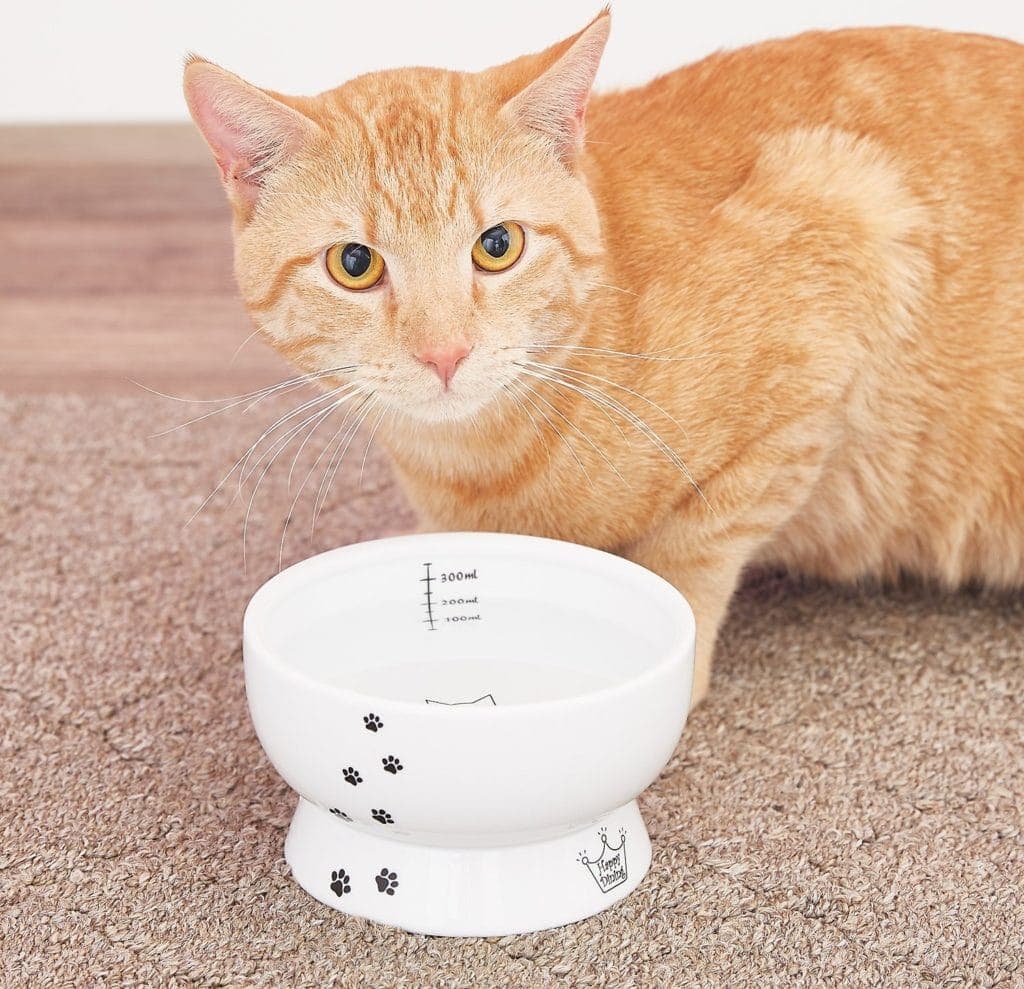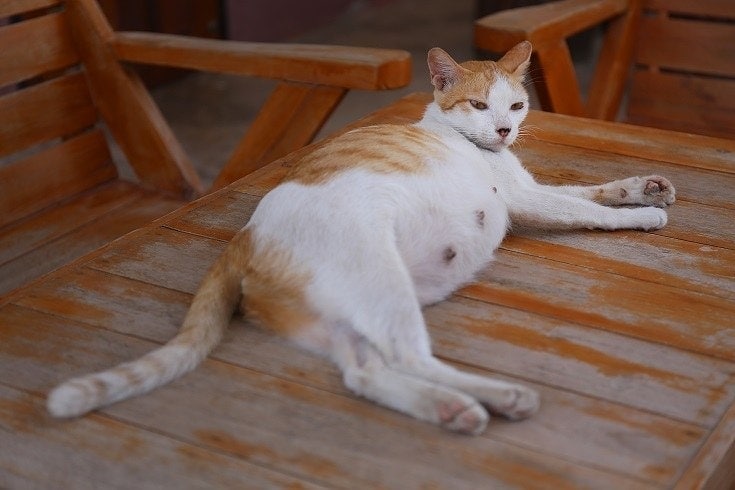How to Get a Cat to Drink More Water: Vet-Approved Tips
Updated on
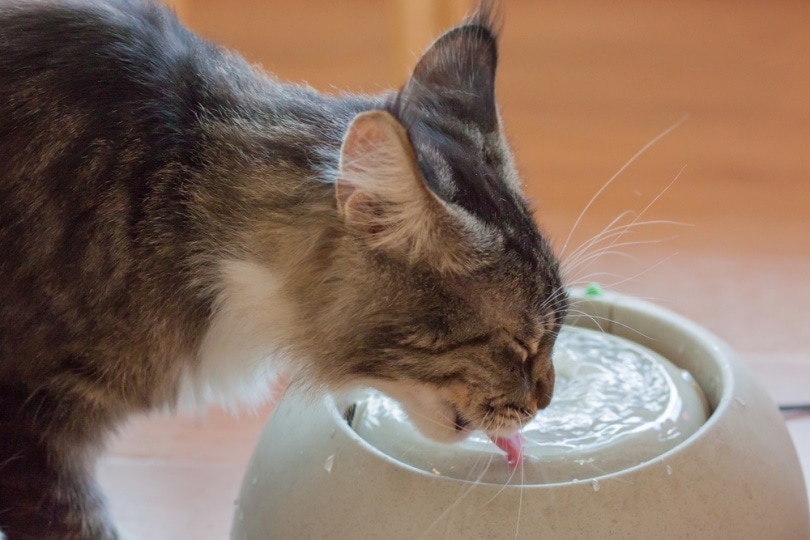
Like every other living creature, staying well-hydrated is also essential for cats. While some cats naturally drink more water, others stay closer to their food bowls than the water bowls. This is not a positive sign because your furry friend needs water every day to stay hydrated, active, and healthy.
To keep our feline pals happy and hydrated, pet owners need to sometimes take matters into their own hands. Whether you have just become a pet owner or have years of experience, you should try to get your cat to drink more water daily. This guide includes 12 helpful expert tips to help you keep your cat in the best physical condition.
 The Importance of Water for Cats
The Importance of Water for Cats
Having enough water in the body is equally important for cats as humans. But how much water is “enough” for cats? The amount of water your cat needs depends on its weight and diet.
For instance, a cat weighing 10 pounds and eating dry food will need approximately 1 -1.3 cups of water daily. However, if the same cat eats wet food, it will need about 1/3 cup of water daily.
Hydration is vital for your cat. Water helps regulate many body functions and is necessary for proper renal function, digestion, joint lubrication, oxygen and nutrient transfer, and blood perfusion.
Drinking enough water also keeps your cat from getting various health issues, including constipation, cystitis, urinary tract infections, and urinary and kidney diseases.
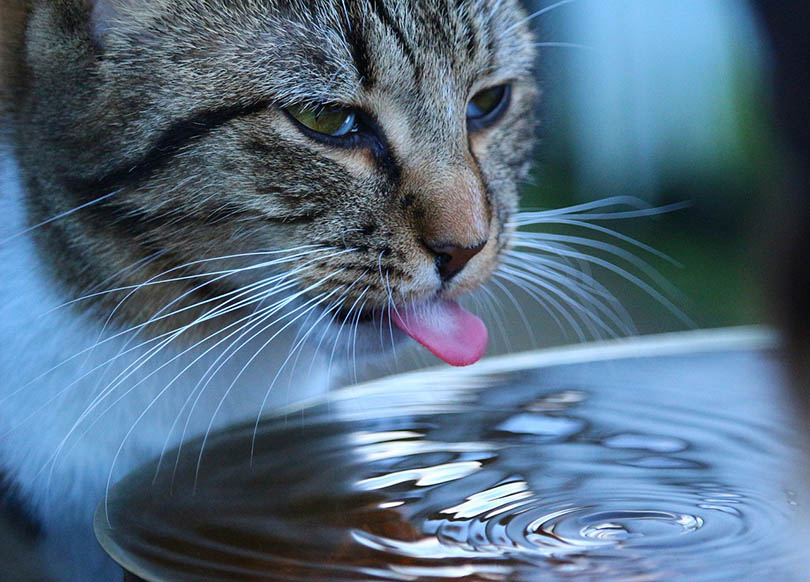
How to Get a Cat to Drink More Water
Now that you understand the importance of water for your cat, the question is how you can make them drink it. You can direct your cat to the water bowl, but that does not mean they will touch it.
To help you out, we have gathered 12 helpful suggestions. You can follow as many as you need to see a positive change in your fur baby.
1. Use Multiple Water Bowls
You must ensure your cat has multiple ways of accessing water. Instead of just one water bowl, you can place numerous bowls in different areas of your home. For example, you can put one water bowl in your bedroom, one in your living room, and one in your kitchen.
If your house has multiple levels, you should put at least one water bowl on every level. Sometimes, cats can be too lazy to stand up and walk to the kitchen. Offering many water bowls gives your cat no excuse for not drinking water.
2. Always Provide Fresh Water
Pets prefer fresh water to what has been sitting around in their bowl for days. Wild cats find their way to fresh, running water in the rivers and streams, but it is difficult for domestic cats to do so.
Thus, you should change your cat’s water supply to fresh water daily. Remember, this does not mean just topping the bowl with more water. Instead, dump the old water from the bowl, rinse it properly, and refill it with fresh water.
You must also watch your cat’s water throughout the day, as a bug or litter may mix with it. So, if you find any particles floating in the water bowl, immediately dump the water and refill the bowl again.
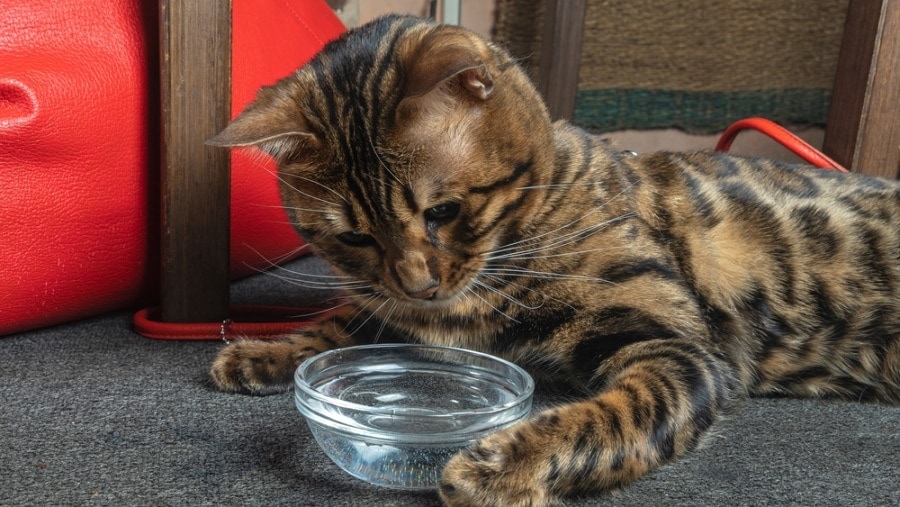
3. Clean Water Bowls Regularly
It is essential to clean your cat’s water bowl regularly, or at least twice a week. You can use a dishwasher to wash its bowl or use your hands with soap and water. However, ensure your pet’s water bowl is dishwasher-friendly before putting it in the appliance.
4. Offer Wet Food
Cats from the olden days have been getting moisture from their prey. This means your cat can also stay hydrated from the food you provide.
A Texas A&M College of Veterinary Medicine & Biomedical Sciences professor, Dr. Debra Zoran, says it is important for cat owners to feed their cats a balanced diet, and it should include wet food to fulfill your pet’s daily water needs.
She further says that cats that only consume dry foods have less water in their body, making them vulnerable to dehydration. Comparing dry pet food with wet food, we can see a significant difference in moisture content. Dry food consists of 10–12%, while wet food has 75–78% moisture.
If you don’t usually feed your cat wet food, you can start doing it gradually and see how your pet reacts to it. Cats typically like the taste of chicken, fish, and beef. You can buy multiple products in these flavors.
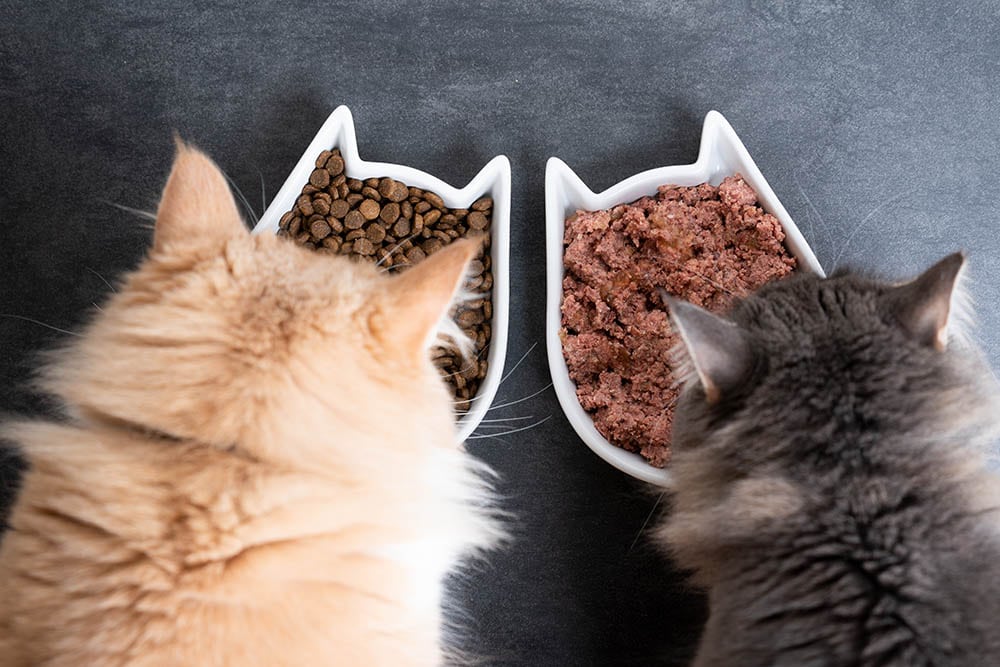
5. Mix Water in Your Cat’s Food
If your cat isn’t drinking enough water, you can add water to the dry food. Some cats that already feed on wet food still don’t intake enough water to fulfill their daily requirement. In such a situation, you can make a food slurry for your cat by adding water to its wet food as well. You should also keep providing water bowls to your cat even if you’re doing this.
Remember, if your cat does not like water-mixed food, never force it, as it may make your cat a rebel. It can even make your pet dislike their food enough to avoid it altogether.
6. Try Another Water Bowl
The quality and shape of your cat’s water bowl are important. Many owners opt for a stainless-steel bowl due to its antibacterial properties, but some cats might not like it.
You should also buy a whisker-friendly water bowl for your bowl. Many cats like wide bowls that keep their whiskers from getting touched while eating or drinking, thus causing whisker fatigue, the over-stimulation of cats’ sensory systems. So, the best way to find the perfect water bowl for your cat is to look for only those designed specifically for felines.
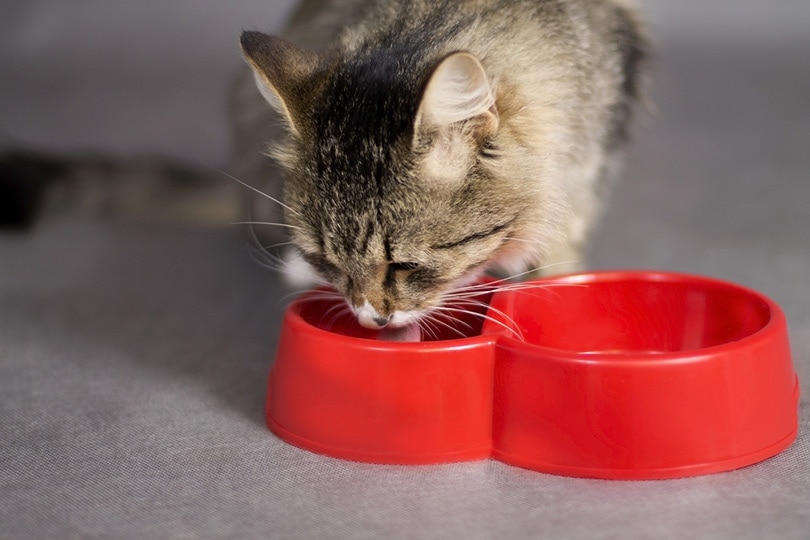
7. Change the Water Type
Some cats are picky about the taste of the water itself. If you have been providing your cat with tap water, try switching to filtered or bottled water. This tip might not change things instantly, but there is nothing wrong with trying it.
8. Offer a Water Fountain
Domestic cats are not usually hunting for freshwater, but some may be. Thus, you can offer your cat running water or water fountains and see if they are attracted to it. You can do so with a dripping faucet in your home or by installing a small cat fountain.
If you want to encourage your cat to drink more water, a great cat water fountain can be just the thing.
- Premium 304-Grade Stainless Steel - This metal cat water fountain is hygienic, with superior...
- Serene & Healthy Cat Drinking Fountain Experience - With whisper-quiet pumping & an advanced...
Our Hepper Stainless Steel Cat Water Fountain has a minimalist, modern design, advanced triple filtration, and adjustable water flow. This fountain is quiet, sturdy, and easy to clean, making it a low-fuss addition to your home.
9. Change the Location of Your Cat’s Water Bowls
Sometimes, even if you put multiple water bowls in your home, your cat won’t still be drinking water from any of them. This might have made you wonder where you went wrong. If you ask the same question, the answer is simple: your cat can’t see or access those water bowls!
So, try changing the location of your cat’s water bowls and ensure they are placed in readily accessible and cat-friendly spots. While doing so, remember that cats like to drink water in peace, usually away from their litter box or food.
10. Use Cold Water
Cats love to try new things, which is why they have preferences for water temperature too. Sometimes, they would like to have ice-cold water, but it just depends on the cat.
If your cat comes close to its water bowl but doesn’t drink water from it, you can add a few ice cubes. The ice could intrigue your cat, and they may lick the cubes out of curiosity. If your cat likes cold water, you should buy a stainless-steel bowl since it will keep the water chilled for extended periods.
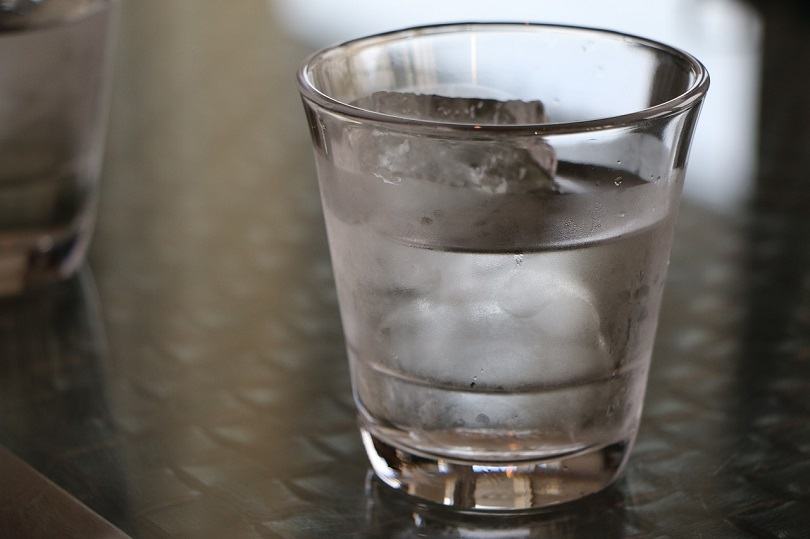
11. Change the Flavor
If your cat is a food lover, they might expect you to provide them with different flavored drinks instead of just plain water. This is similar to adding lemons or cucumbers to your water to make it more refreshing. So, in your cat’s case, you can offer them chicken broth or bone broth as alternatives.
Make sure both these options are low in sodium and without any spices. That is because salt, garlic, onions, and herbs can be toxic for your cat. Consulting with a vet is the right way to determine a safe water alternative for your feline friend.
12. Raise the Water Bowl for the Perfect Angle
Last but not least, some cats simply don’t drink water out of water bowls because they need to be placed at the perfect angle. That’s especially the case with older or bigger cat breeds, which suffer from different medical conditions due to their body size.
Try elevating your cat’s water bowl to make it more comfortable for your pet to drink water. Measure your cat’s height to find the correct distance of the bowl from the ground and raise it accordingly.
 Conclusion
Conclusion
Drinking water is essential for your cat’s optimal health. Your kitty needs water to stay hydrated, which, in turn, prevents the animal from different diseases and keeps their temperature regulated. However, some cats simply don’t like drinking much water.
If your cat doesn’t go close to its water bowl, you can try another bowl in a different material and shape. You can also place water bowls in multiple places in your home, mix water in your cat’s food, and try offering your pet varying water alternatives upon your vet’s consultation.
Related Reads:
Featured Image Credit: elwynn, Shutterstock

 The Importance of Water for Cats
The Importance of Water for Cats

